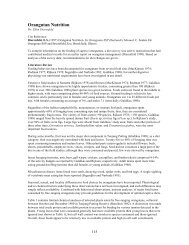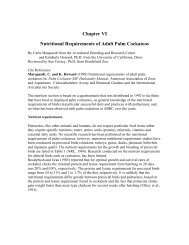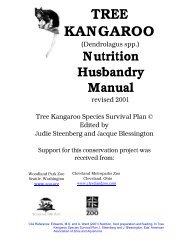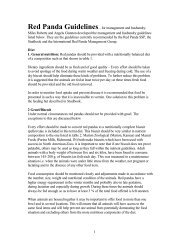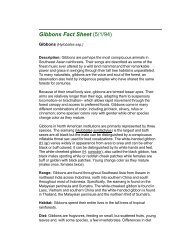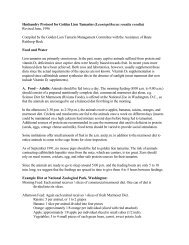Development of Hand-rearing Techniques for Roseate Spoonbills
Development of Hand-rearing Techniques for Roseate Spoonbills
Development of Hand-rearing Techniques for Roseate Spoonbills
You also want an ePaper? Increase the reach of your titles
YUMPU automatically turns print PDFs into web optimized ePapers that Google loves.
chicks will stay up <strong>for</strong> a while and were at their noisiest. Each chick generally defecated at<br />
feeding time.<br />
Growth<br />
Based on available data, hand-reared birds never reached weights comparable to parent-reared<br />
birds at 7 and 14 days <strong>of</strong> age (Figure 1). Data points include the average <strong>of</strong> all birds hand-reared<br />
during that year. The first fledgling collected in 1982 was approximately 14 days old. The first<br />
chick hand-reared from day one <strong>of</strong> the 1987 hatch achieved the highest weight comparable<br />
to adult-reared chicks or 73 % <strong>of</strong> their weight. A chick hand-reared from approximately 6 days <strong>of</strong><br />
age in 1988 did equally well, achieving 76% <strong>of</strong> adult-reared chick weight by day 14.<br />
Birds were not hand-reared again until 1993. These birds these chicks achieved only 30 % <strong>of</strong> the<br />
parent reared chick weights at 7 and 14 days <strong>of</strong> age. Growth rates improved over time with the<br />
birds hand-reared in 1997 reaching 60% <strong>of</strong> the parent reared weights at 7 and 14 days.<br />
By 1997, hand-reared birds were consuming as much 100 % <strong>of</strong> their body weight per day in<br />
<strong>for</strong>mula during these first 14 days. The 1993 birds had only been consuming 40 % <strong>of</strong> their body<br />
weight in <strong>for</strong>mula daily during this same time. Solids including, lake smelt, Bird <strong>of</strong> Prey<br />
diet, and Flamingo pellets were not introduced to the 1997 birds until 18 days <strong>of</strong> age. At 30 days<br />
<strong>of</strong> age these birds were still consuming 30- 40 % <strong>of</strong> their body weight in <strong>for</strong>mula daily. Solid<br />
food consumption at this time was approximately 6 % <strong>of</strong> body weight daily. It is possible the<br />
quicker incorporation <strong>of</strong> a solid diet into the <strong>rearing</strong> <strong>of</strong> the 1982, 1987, and 1988 birds accounts<br />
<strong>for</strong> the differences in body weights. The solid food items are higher in energy content than the<br />
liquid diet (Table 3.)<br />
Two <strong>of</strong> the four chicks died, one on day 3 and one on day 4. Cause <strong>of</strong> death was not clear. The<br />
two that survived were weighed until day 15 (Figure 1).<br />
DISCUSSION<br />
Collection<br />
<strong>Spoonbills</strong> typically lay 3-4 eggs. No more than 50% <strong>of</strong> eggs or chicks from anyone nest were<br />
taken during the collection process and usually only one was taken per nest regardless <strong>of</strong> the total<br />
number. Each year, in conjunction with the USFWS, the zoo collected from a different area along<br />
the Texas coast in hopes <strong>of</strong> getting specimens from distinctly different gene pools. A genetics<br />
study in progress with the University <strong>of</strong> North Texas will eventually determine if this method<br />
was successful.<br />
Feeding<br />
It is easier to feed using several 20 cc syringes than to struggle with a 60 cc syringe when the<br />
chicks are able to consume 60 ccs or more per feeding. It requires one hand to steady the chick.<br />
The chicks have developed a good feeding response by day 4, sitting up on the hocks, head and<br />
neck extended up, head bobbing and vocalizations <strong>of</strong> a high shrill triill.



